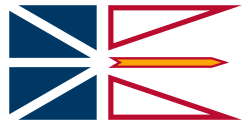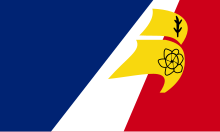Flags of Newfoundland and Labrador
The flag of Newfoundland and Labrador was introduced in 1980. It has an aspect ratio of 2: 1 and combines various symbols. In addition to the flag of Québec , it is the only flag of a Canadian province that does not feature the provincial coat of arms.
The flag consists of two parts, both of which are outlined in white. In the left (slightly narrower) part there are four blue right-angled triangles , each separated by a white stripe. The right half shows two red-framed white right-angled triangles, in between a red-framed golden arrow pointing to the right.
The blue symbolizes the sea, the white the snow and ice of winter, the red the efforts and hardships of the residents of Newfoundland and Labrador, the gold the trust of the residents in themselves. The blue triangles are arranged so that they remind of the British Union Flag ; they represent the British heritage of the residents of Newfoundland and Labrador. The two red-framed triangles symbolize the two regions of the province, the mainland and the island. The arrow points to a better future and, when the flag hangs vertically, has similarities with a sword honoring the sacrifices made by the soldiers. The triangles outlined in red and the arrow together form a trident that represents the province's dependence on fishing and marine resources.
Origin of today's flag
In the late 1970s, Brian Peckford , the then Prime Minister, set up a commission to design a new flag. Since joining the Canadian Confederation on March 31, 1949, the province had used the British Union Flag.
The Newfoundland Historic Trust , Newfoundland Historical Society, and St. John's Folk Arts Council recommended that the Newfoundland House of Representatives introduce the green, white and pink tricolor, which had been widespread during the 19th century and was later largely forgotten. Although the tricolor has similarities with the flag of Ireland (also in symbolism), it is five years older than this and also the oldest flag in the world with the color pink.
However, the commission rejected the proposal and supported the proposal by artist Christopher Pratt . On May 28, 1980, the House of Representatives adopted the new flag. It was first hoisted on June 28, 1980, on the anniversary of the landing of Giovanni Caboto .
Tricolor
A popular but unofficial flag is the Newfoundland tricolor . It has an aspect ratio of 2: 1 and shows three equally wide posts in the colors green, white and pink. The flag is said to have been designed in St. John's in 1843 by Michael Anthony Fleming , the Roman Catholic Bishop of Newfoundland. The seal hunters collected firewood for churches, schools and other social institutions outside of the hunting season. Catholic and Protestant wood collectors tried to outdo each other, which often led to fights. The Protestant English marked their wood with pink flags, the Catholic Irish with green flags.
As the clashes became more violent, President William Carson suggested that the bishop be used as a mediator. Bishop Fleming tied the flags of the conflicting parties with a white handkerchief to symbolize peace. Although the history of its origins cannot be precisely proven, the flag spread rapidly and was used repeatedly, especially by those who opposed Newfoundland joining the Canadian Confederation . At the beginning of the 20th century, the flag fell out of use.
Ensigns
From 1904 to 1931 the Red Ensign and the Blue Ensign with the Great Seal in the flight section were the unofficial flags of Newfoundland. Merchant ships used the Red Ensign and government ships used the Blue Ensign. The parliament of the then independent state officially introduced neither of the two flags, but the Red Ensign was used so often on land and at sea that it could be used as the unofficial state flag. Mercury , god of trade, is shown on the seal, showing Britannia a kneeling fisherman with a net and offering her the riches of the sea. Above the three people there is a scroll with the words Terra Nova , on the lower edge the motto Haec Tibi Dona Fero (“I will bring you these presents”).
Union Flag
The old official flag of Newfoundland was the British Union Flag . It was introduced in 1931 and used until the self-government was suspended in 1934. In 1952, three years after joining Canada, the provincial government reintroduced the Union Flag as the official provincial flag and used it until 1980. The Newfoundland and Labrador section of the veteran organization Royal Canadian Legion does not recognize the new flag of Newfoundland to this day, because during the During both world wars the Newfoundland soldiers served under the Union flag. The Royal Canadian Legion hoists the Union Flag on all of its official occasions.
Flag of the Franconianfoundland
The flag of the Fédération des Francophones de Terre-Neuve et du Labrador , representing the French-speaking population of the province, is based on the French tricolor and the flag of the Acadians . It consists of three unequal sized fields in blue, white and red, whereby the fields are divided diagonally. Two yellow sails are shown on the dividing line between the white and red fields. The upper sail also has a spruce branch, the lower sail a pitcher plant . Both emblems are outlined in black.
The sails symbolize Basque , Breton and French fishermen who came to this area at the beginning of the 16th century. In addition, the sails stand for energy and progress. The yellow color comes from the star on the flag of the Acadians. The spruce branch is the emblem of Labrador, the pitcher plant the official flower of the province.
Flag of Labrador
Labrador , the mainland part of the province, has its own unofficial flag. It consists of three horizontal stripes in the colors white, dark green and light blue, with the middle dark green stripe being half as wide as the other two. In the upper left corner, in the white stripe, there is also a green spruce branch.
In 1973, the Newfoundland government encouraged its citizens to undertake various cultural projects in view of the 25th anniversary of the province's accession to the Canadian Federation. Michael Martin, the MP for the Labrador South constituency, took this as an opportunity to protest against Prime Minister Joey Smallwood's indifference to Labrador. Together with like-minded people he designed a flag to consciously differentiate Labrador from the dominant island and to give the neglected mainland part of the province its own identity.
Martin's wife sewed 64 flags: one each for the 59 localities in Labrador, one each for the three Labrador members in the provincial parliament and two for the Martin couple personally. The flags were sent to the localities and hoisted there on March 31, 1974, exactly 25 years after the province joined Canada. The three MPs received their flags on April 1st in St. John's during a public ceremony in the House of Parliament.
Flag of Nunatsiavut
Since December 1, 2005, the self-governing region has Nunatsiavut the Inuit own flag. It was introduced by the Labrador Inuit Association and, like the flag of Nunavut , shows an Inuksuk , a pile of stones that guides people and marks sacred and other special places. The colors white, dark green and light blue correspond to those of the flag of Labrador.
Web links
- Provincial flag. Government of Newfoundland and Labrador
- Flag history of Newfoundland and Labrador
- Reflections on the flag of Labrador. New England Journal of Vexillology






